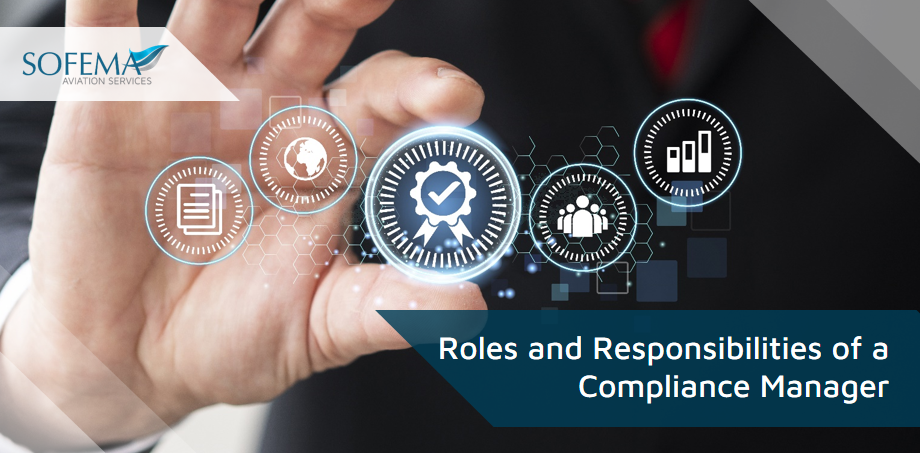Sofema Aviation Services (SAS) www.sassofia.com considers key elements of an effective Compliance System together with the Roles and Responsibilities of the Compliance Manager (CM)
Introduction
Who is responsible for quality in an organisation?
An answer that is often given is the Quality Manager (Compliance Manager). In fact, please Note that while the Compliance Manager is responsible for delivering an effective Quality Assurance System, the CM is not responsible for Quality Control (QC).
Who is responsible for QC?
Nominated Persons / Post Holders and business area owners are directly responsible for Quality Control within their respective business areas! The Compliance Manager is integral in ensuring the delivery of an effective Quality Assurance (QA) system within an organization. This role involves coordinating and overseeing various processes to maintain and enhance the quality of products or services, ensuring they meet regulatory standards and customer expectations.
- To deliver an effective quality system requires a fundamental understanding and a recognition of the differences between:
o Quality Assurance (QA),
o Quality Control (QC) and
o Safety Management, and
o Persons with specific responsibilities for delivering the various elements.
To achieve this, the Compliance Manager must have a deep understanding of several key components:
QA refers to the independent assessment that confirms the various processes for ensuring that products or services meet specified requirements.
It encompasses the entire production process and is proactive in nature. It aims to prevent defects through planned and systematic activities.
QC is the process of ensuring that products or services meet the required standards through ongoing inspection and testing.
It is reactive, focusing on identifying defects in finished products or services.
Safety Management – Involves implementing and maintaining systems to ensure the safety of employees, customers, and other stakeholders.
It focuses on preventing accidents and managing risks.
To consider a typical Compliance Manager’s roles & responsibilities within a combined Quality System (OPS +145)
- Responsible for establishing, documenting, developing, and managing the Compliance System and ensuring that it continues to comply with regulatory requirements and meet the business’s needs.
- Ensure that all quality-related policies and procedures detailed in the Operations, Quality, and Company Exposition manuals are adhered to, and carry out an ongoing review of the adequacy and effectiveness of Compliance System procedures.
- Maintain and keep all Compliance Audit and inspection records current for review by the Competent Authority and other external bodies as appropriate.
- Liaise with the authority as appropriate on matters related to the compliance system.
- Establish procedures for dealing with non-conformities, including monitoring non-conformity reports and taking corrective/preventive action in response to audit findings.
- To Notify the Accountable Manager and Senior Management when Management Review meetings are scheduled and to present internal audit reports.
- Review the Quality / Compliance Systems of new subcontractors who impact the operation and organize audits (Either Physical, Remote Webinar or postal) of their Quality / Compliance systems.
- Monitor compliance with and adequacy of procedures to ensure airworthy aircraft at all times via an audit programme and ensure all maintenance is performed per approved data.
- Monitor all contracted maintenance to comply with airworthiness contract conditions and ensure that contracted organisations have the relevant Part 145 Approvals and facilities.
- Monitor the aircraft weighing programme for compliance with OPS Requirements.
- Monitor all certificate renewals, including renewal test flights, relevant to the certification and operation of each company aircraft.
- Control the use and application of the Company Minimum Equipment List insofar as it affects airworthiness.
- Grant authorisation to individuals to certify the Certificate of Release to Service and special authorisations to issue Certificate of Maintenance Review and renewal recommendations for Certificates of Airworthiness.
- Grant authorisations to individuals to issue EASA Form 1 for work carried out under the Part 145 Approval.
- Coordinate reports of unairworthy conditions.
- Support the definition and development of the training syllabus in conjunction with the relevant Postholder and Business Area Owner.
- Ensure the organisation holds all appropriate technical publications.
- Coordinate all aspects of the Company Exhibition / Compliance Manual and the negotiations (Change Management) with the Regulatory Authority regarding any changes required to the documents or to the Terms of Approval granted by the Authority to the company.
- Analyse all relevant data and circulate it within the company for information, with recommendations for improvement in quality standards as required.
- Assume overall responsibility for the control of Quality / Compliance records.
- Be the final authority in the authorisation and acceptance of release to service of any aircraft or part thereof, including but not limited to :
- The issue of MEL repair period over-run authorities (RIO). (If relevant)
- The issue of dispensations allowing the fitment of an aircraft component that does not have the appropriate release certification at overseas locations is only in accordance with Part 145.A50(f). (If relevant)
- The issue of Dispensations granting one-off authorisation for the circumstances described in Part 145.A.30(j5) (If relevant)
Next steps
Follow this link to our Library to find & download related documents for Free.
For more information regarding training and consultancy support, please see www.sassofia.com or email team@sassofia.com
Tags:
Aircraft, aviation, Aviation Quality, Aviation Quality System, aviation safety, EASA, EASA Part 145, Part 145, Part 145 Approval, Aviation Safety Management, OPS, SAS blog, Operational Management, Maintenance Compliance Manager, review




